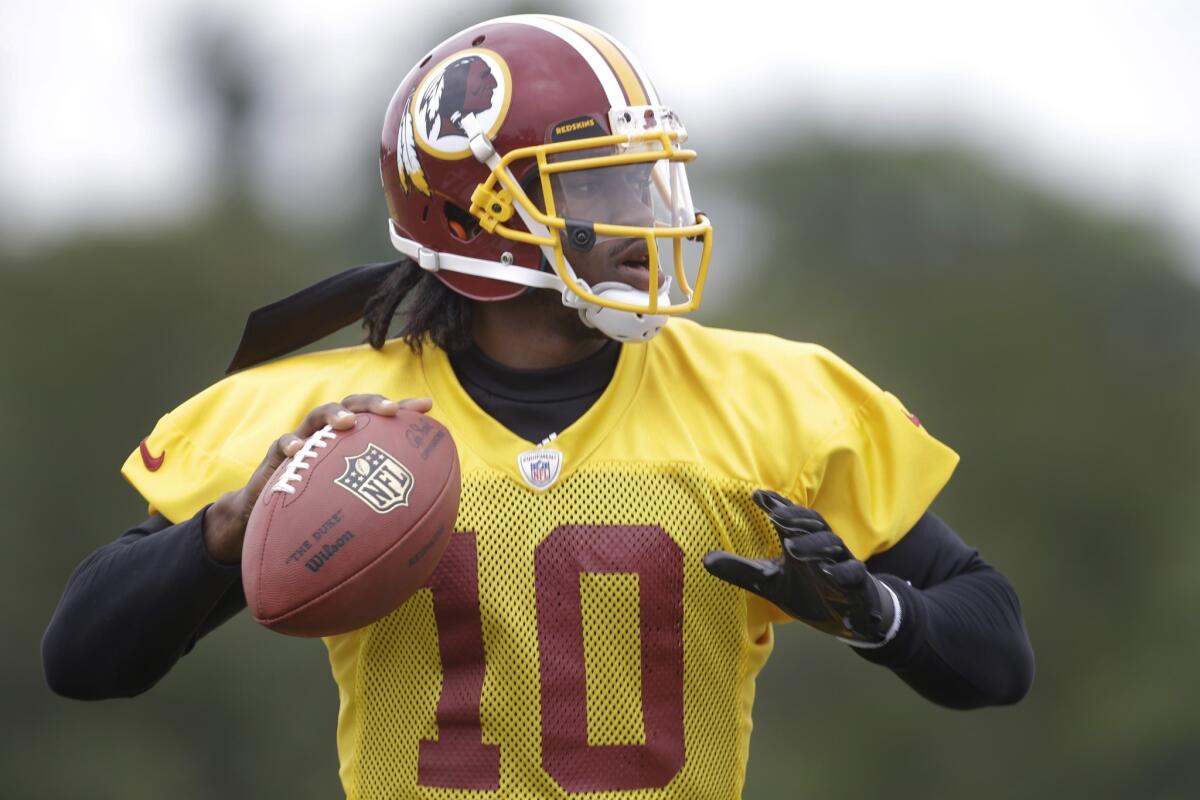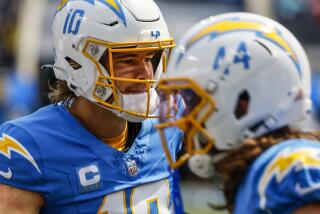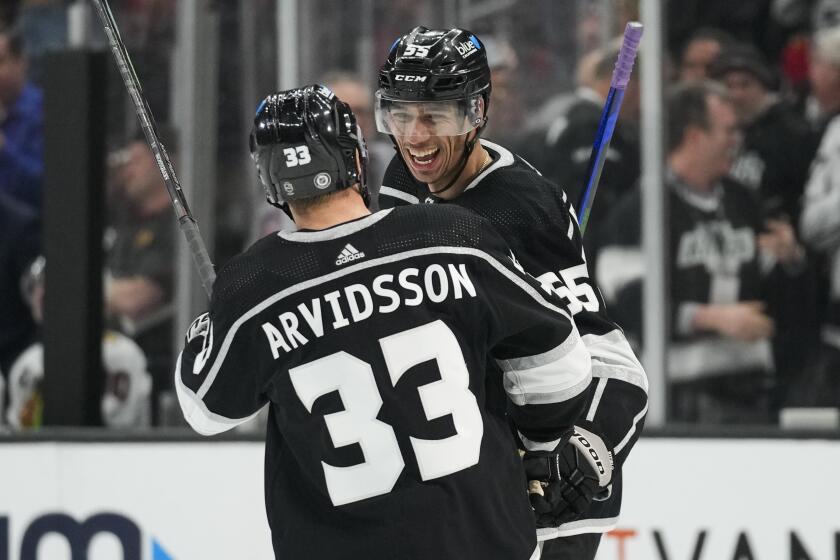Read-option offense could make NFL quarterbacks an endangered species

Quarterbacks are the most protected players in the NFL. The league revolves around them.
Running backs are the least protected players. Even helmet-to-helmet hits are legal against them.
In a read-option offense, a scheme rapidly gaining popularity in the league, a quarterback often looks like a running back, whether he actually has the ball or is simply pretending to hold it.
So what happens when an irresistible force — a defensive player hellbent on taking a free shot at the quarterback — meets an otherwise untouchable object?
We may find out early and often next month, as pro defenses have had a lot more time to prepare for offenses that last year seemed exotic. There’s a belief among many people in NFL circles that running quarterbacks will pay the price this season, more than they did last fall, against defenses that are not going to be as tentative and under-prepared. That’s a potential problem for the league.
“Every guy I’ve talked to is going to go after the quarterback,” said Hall of Fame coach John Madden, co-chairman of the NFL’s safety committee. “That’s going to be their answer. If you watch what they did last year, a lot of guys played the quarterback. If he pitches, get off him. If he keeps it, tackle him. Now, they’re just going to go after him whether he pitches or not.”
When a quarterback tucks the ball and runs upfield, he becomes a running back and therefore loses the generous protection afforded quarterbacks in terms of when and how they can be hit. It’s an ominous loophole.
NFL rules stipulate hitting the quarterback after the ball leaves his hands is unnecessary roughness, as long as the quarterback is either standing still or moving backward. However, sometimes a read-option quarterback continues to carry out the fake as if he has the ball.
“The key is the posture of the quarterback,” said Dean Blandino, the league’s vice president of officiating. “You can’t take a free shot at him. But what we’re seeing in some instances is the quarterback hands off and then carries out the fake like he has the ball, and he’s presenting a running posture.
“In that instance, he’s trying to deceive the defense, trying to draw the defense to him, and he doesn’t have special protection in that situation. He can be hit until enough time has passed where he’s clearly out of the play.”
Blandino said the competition committee made it clear this off-season that it wanted officials to re-emphasize the protection policies to teams. Officials visited all 32 teams and showed video of the plays in question, and officials have talked about it with players and coaches at training camps.
“There’s really no change in how we’ve officiated it and what the rules are,” Blandino said. “But it has been a point of emphasis.”
Madden said most opposing defenses didn’t have sufficient time to prepare for read-option schemes last year, but he expects them to be far more efficient and aggressive in that department this season.
“They’re not going to be caught on their heels this year,” he said.
All around the league, defensive coaches went back to their college counterparts for tips on how to contain the new wave of mobile quarterbacks such as Washington’s Robert Griffin III — coming off a major knee injury — Seattle’s Russell Wilson and San Francisco’s Colin Kaepernick.
“Obviously, [the read option] is very effective and has been, but some of these defensive coaches now, they’re not sitting around looking out the window and having coffee,” New York Giants Coach Tom Coughlin said. “They’re into it. You’ve also stimulated an awful lot of that. And that’s a good thing. The energy level on the defense end of the hall in most buildings has been perked up by what’s happened.”
Pittsburgh Steelers Coach Mike Tomlin said in March that he expects defenses to catch up to read-option schemes quickly and make adjustments that will make offensive coaches think twice about putting their quarterbacks in that type of peril.
“I think the read option is the flavor of the month,” Tomlin said. “We will see whether it’s the flavor of the year. A few years ago, people were talking wildly about the Wildcat. There’s a lot less discussion now. I think that there are coaches in rooms preparing themselves to defend it, coaches in rooms that are also preparing themselves to run it, and I think it is going to sort out on the grass.”
In a divisional playoff loss to the 49ers last season, Green Bay had no defensive answers for Kaepernick, who ran for a playoff-record 181 yards and two touchdowns and threw for two scores in a 45-31 victory.
Packers linebacker Clay Matthews, for one, would take a different approach to that type of running by quarterbacks this season.
“I like to get after it. I like to just be going for it, getting after the quarterback,” Matthews told ESPN recently. “With this, it’s the complete opposite. You have to sit there and play patty cake with the tackle, making sure the quarterback doesn’t escape the pocket. You have to read and make sure who’s taking the ball, who’s not. It’s difficult for me to just kind of sit back, especially when Kaepernick was having such success throwing the ball that game too, which caught us by surprise.”
In the wake of that humiliating loss to the 49ers, the Packers sent their defensive staff to College Station, Texas, to meet with Kevin Sumlin’s staff at Texas A&M for an informal clinic on dealing with the read option.
When Packers Coach Mike McCarthy talked about that offense in March, he sounded as if he were issuing a challenge to opponents who dared to take the same approach as the 49ers.
“If I was playing against us, I’d make sure if we had that kind of quarterback that you would test the Green Bay Packers,” he said. “Everybody’s going to watch the last game. Let’s not be naive to that. Time will answer that. It’s like any scheme; you have to stop it.”
Rob Chudzinski, first-year coach of the Cleveland Browns, used a version of the read option as offensive coordinator in Carolina, with Cam Newton at quarterback. That experience, Chudzinski said, now will benefit him on the defensive side.
“We feel very confident that from a defensive perspective we can come up with some schemes and we can get those schemes taught to take care of it,” he said.
Re-training defensive players won’t necessarily be easy, though.
“NFL defensive ends and outside linebackers are not used to having to sit there and read a mesh point between a quarterback and a running back,” said NFL Network personnel expert Mike Mayock, referring to the moment of a handoff, or faked handoff, when it’s unclear who is keeping the ball.
“The DeMarcus Wares of the world just want to come off the edge and create havoc,” he said, referring to the Dallas Cowboys’ star pass rusher, “and you can’t do that. When you’ve done one thing for a lot of years — and maybe you haven’t played against any option since you were in junior high — and now you’re seeing something new. Last year it caught some teams by surprise.”
If quarterbacks begin to absorb an increasing number of hits, the read-option strategy will go the way of leather helmets.
“If they allow the quarterback to take some pretty good shots, and all of a sudden he goes from being hit four times a game to 15 times a game, then coaches will be very leery of doing that,” said Greg Cosell, analyst and senior producer at NFL Films.
Put simply by Arizona Cardinals Coach Bruce Arians: “If you put a quarterback in harm’s way enough times, harm will come to him.”
Twitter: @LATimesfarmer
More to Read
Get our high school sports newsletter
Prep Rally is devoted to the SoCal high school sports experience, bringing you scores, stories and a behind-the-scenes look at what makes prep sports so popular.
You may occasionally receive promotional content from the Los Angeles Times.







